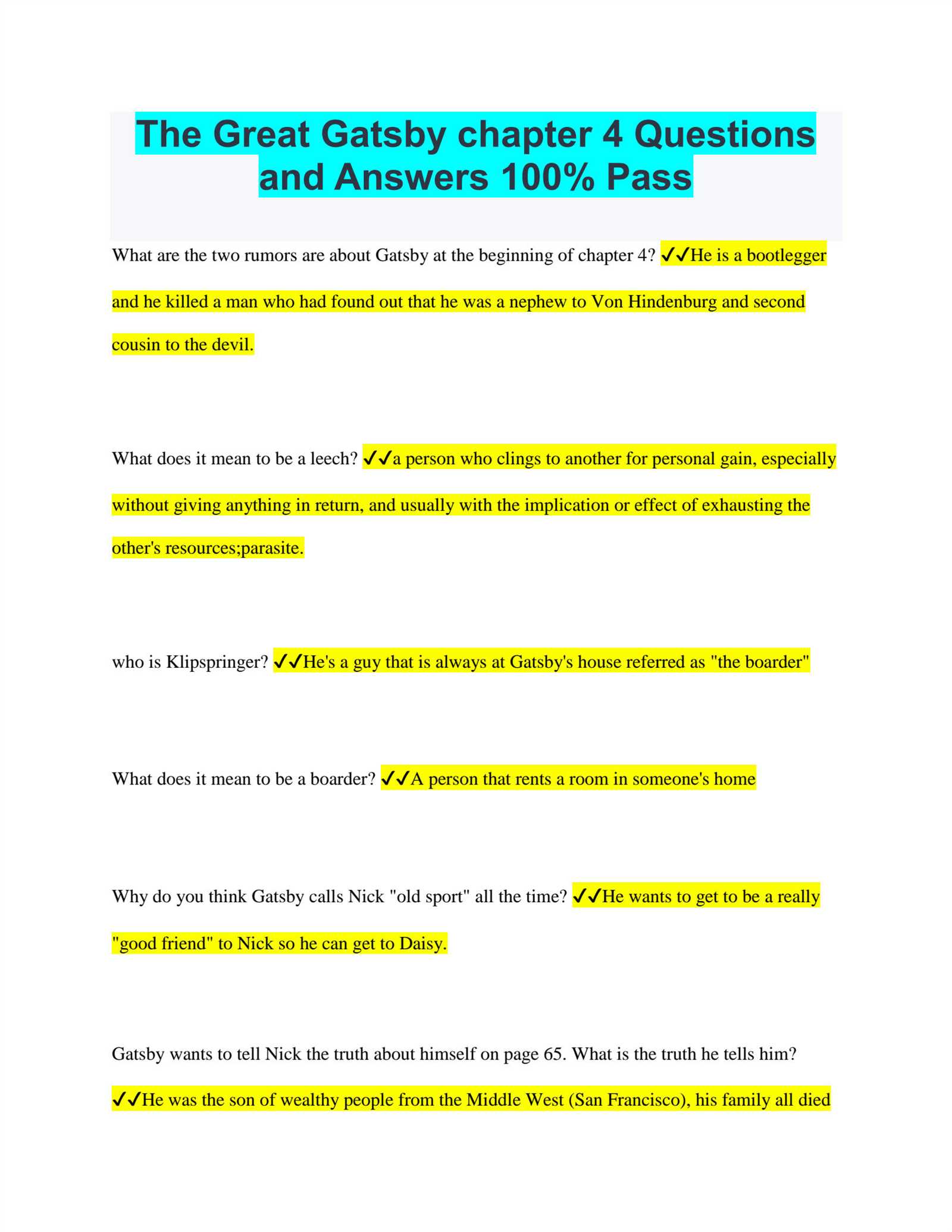
In this section, we will dive deep into the crucial events and characters introduced early in the novel. By analyzing the key moments and interactions, readers can better understand the themes and motivations that unfold throughout the story. The initial chapter sets the tone, offering a glimpse into the world and society where the characters reside.
Through the lens of the narrator, we explore significant relationships and the contrasts between different social circles. We also examine the symbolism embedded within the narrative, which enriches the unfolding drama. Each detail, from subtle character traits to larger societal observations, adds complexity to the narrative and invites deeper reflection.
By focusing on these pivotal aspects, this section aims to provide clarity on how the story begins, guiding readers through important developments. As we analyze each part, the importance of setting, character introductions, and foreshadowing will come into sharper focus, revealing the groundwork for future events.
Understanding Key Moments in Chapter 1
The opening moments of the story set the stage for the entire narrative, introducing readers to critical characters, settings, and themes. These events establish the foundation for the novel’s exploration of wealth, ambition, and social dynamics. By focusing on specific incidents and their implications, we can uncover the deeper layers that drive the plot forward.
Introduction of Main Characters
- Nick Carraway: The narrator whose observations guide the reader through the unfolding drama.
- Tom Buchanan: A wealthy, arrogant figure whose actions hint at the tension to come.
- Daisy Buchanan: A symbol of beauty and wealth, whose emotional depth is hinted at early on.
- Jordan Baker: A woman with a mysterious air, whose connection to Daisy begins to surface.
Setting the Scene
- East Egg vs West Egg: The stark contrast between these two locations highlights class divisions and social aspirations.
- Nick’s Perspective: As an outsider, Nick’s viewpoint adds a layer of objectivity and intrigue to the events.
- First Glimpse of Gatsby: The mysterious figure seen in the distance offers a sense of anticipation and curiosity, foreshadowing his role in the story.
These key moments not only introduce us to the world of the characters but also hint at the larger conflicts that will unfold throughout the narrative. Each interaction and setting contributes to a growing sense of mystery and tension, making this opening chapter essential to understanding the novel’s direction.
The Setting of The Great Gatsby
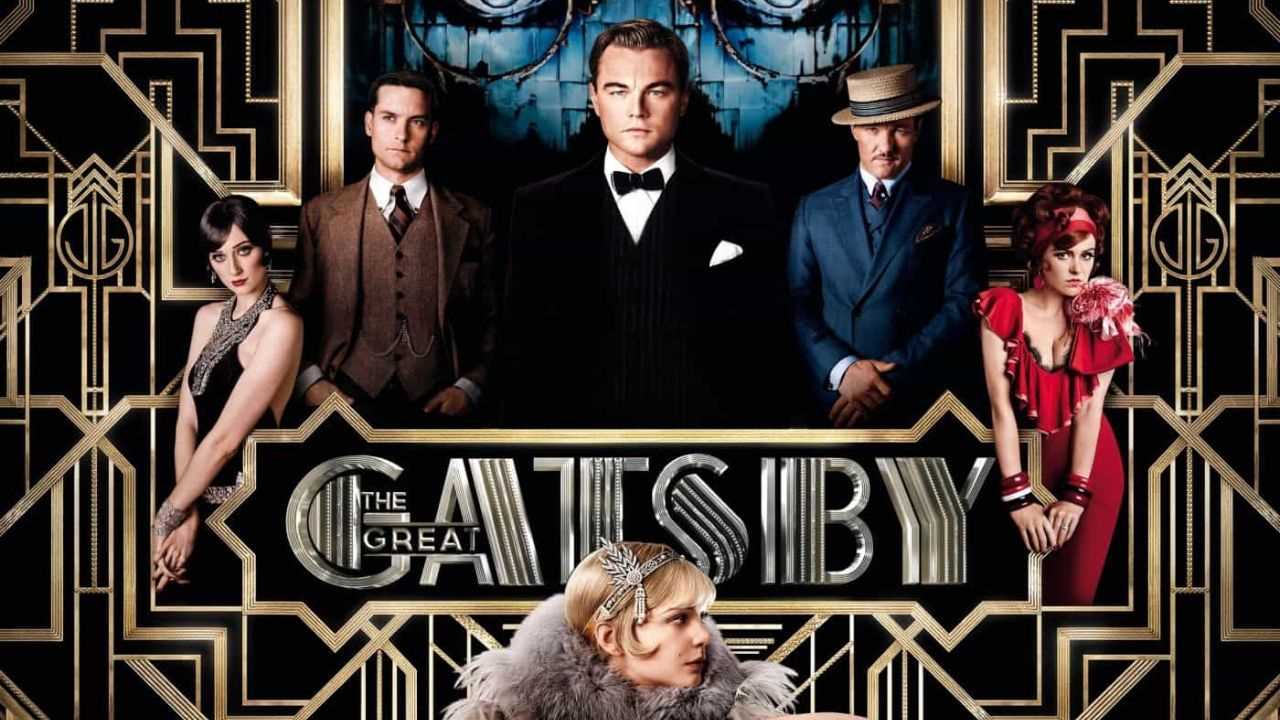
The environment where the story takes place plays a crucial role in shaping the narrative’s themes and character interactions. The geographical locations and their social implications highlight the contrasting worlds inhabited by the main figures. By examining these settings, we gain insight into the dynamics of wealth, class, and ambition that drive the story forward.
Two prominent areas are introduced early on, each representing distinct social classes and ways of life. East Egg symbolizes old money and tradition, while West Egg is a more modern, yet less refined, setting for the newly wealthy. This divide influences the characters’ behaviors and expectations, making the geographical context integral to understanding their motivations.
Additionally, the valley of ashes serves as a stark contrast to these affluent regions, representing the moral decay and the struggles of the lower class. It is in this bleak setting that important moments of the plot unfold, underscoring the themes of disparity and corruption that pervade the story.
Nick Carraway’s Role in the Story
As the narrator, Nick Carraway serves as both an observer and a participant in the events that unfold. His perspective is key to understanding the world and characters around him, providing a lens through which the reader experiences the narrative. Although he is not always at the center of the action, his observations shape the tone and depth of the story.
Nick’s background as an outsider, having come from humble beginnings, allows him to navigate the social circles of wealth and privilege with a unique viewpoint. His honest, yet often ambivalent, reflections on those around him provide a balanced portrayal of the characters’ flaws and virtues. He plays a pivotal role in establishing the moral framework of the novel, often questioning the values of the people he encounters.
Throughout the story, Nick’s relationships with key figures, especially the enigmatic man across the bay, deepen his involvement in the central conflicts. His role as a confidant and observer allows him to witness and record events that, while personal, have wider implications for the narrative’s exploration of aspiration, disillusionment, and tragedy.
Tom Buchanan’s Character Analysis
Tom Buchanan stands as one of the most complex and morally ambiguous figures in the story. His wealth and social status often mask his insecurities and deep-rooted flaws, but his actions reveal a sense of entitlement and dominance. As a central figure in the narrative, Tom’s behavior influences the dynamics between other characters, especially in terms of power, control, and relationships.
Personality Traits
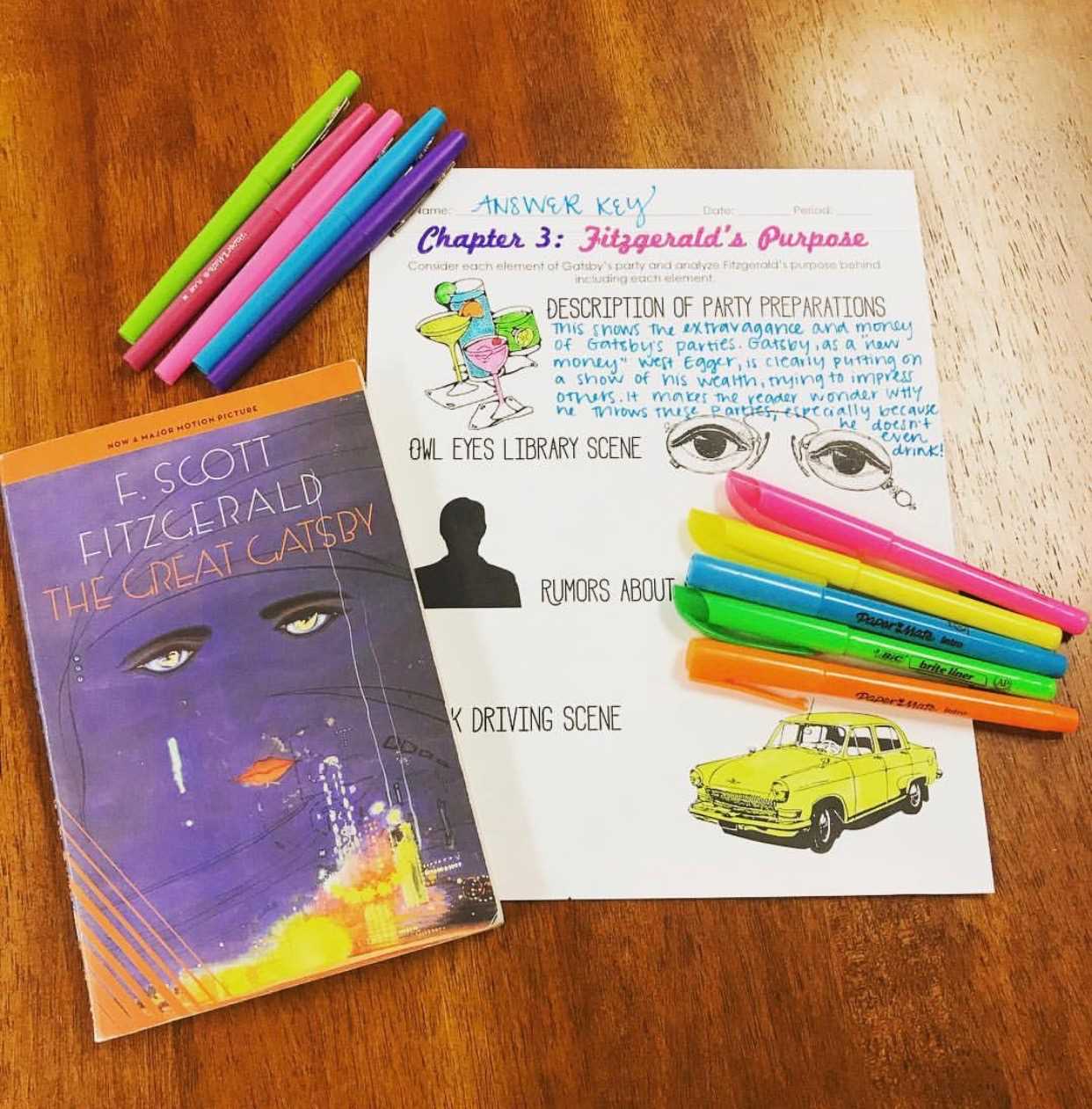
- Arrogance: Tom’s sense of superiority is evident in his interactions, often belittling others to assert his dominance.
- Impulsiveness: His decisions are often driven by desire and emotion, without regard for the consequences or the feelings of others.
- Racism and Prejudice: His prejudiced views are openly expressed, further reflecting his belief in his own superiority.
Role in Relationships
- With Daisy: Tom’s marriage to Daisy appears to be built on control and possession, rather than mutual respect or affection.
- With Myrtle: His affair with Myrtle Wilson highlights his lack of emotional connection and his need to exert power over others.
Overall, Tom Buchanan represents the darker aspects of wealth and privilege, using his resources to manipulate and maintain control. His character is crucial in understanding the tensions that drive the plot and the tragic outcomes that unfold as the story progresses.
The Significance of East Egg vs West Egg
The geographical divide between East Egg and West Egg is more than just a physical separation–it symbolizes the deeper social and economic distinctions that shape the characters and their relationships. These two areas represent contrasting ways of life, each influencing the behavior, values, and aspirations of those who live there. Understanding this divide helps explain the tensions and conflicts that emerge throughout the story.
- East Egg: The home of established wealth and old money. Its residents, like Tom and Daisy Buchanan, are heirs to their fortunes, living in a world of privilege and tradition.
- West Egg: A symbol of new money, where people like Nick Carraway and Jay Gatsby reside. The inhabitants are often self-made, eager to prove their worth but lacking the refinement and legacy of their East Egg counterparts.
This contrast between old and new money is central to the themes of the narrative. The inhabitants of East Egg tend to look down on those from West Egg, viewing them as less refined, despite their wealth. On the other hand, those from West Egg often feel resentful of being excluded from the traditional aristocracy of East Egg, fueling their desire to fit in and gain acceptance.
Ultimately, the divide between these two locations highlights the disparities in social class and underscores the broader theme of the American Dream, illustrating the tension between inherited privilege and self-made success.
The First Glimpse of Gatsby
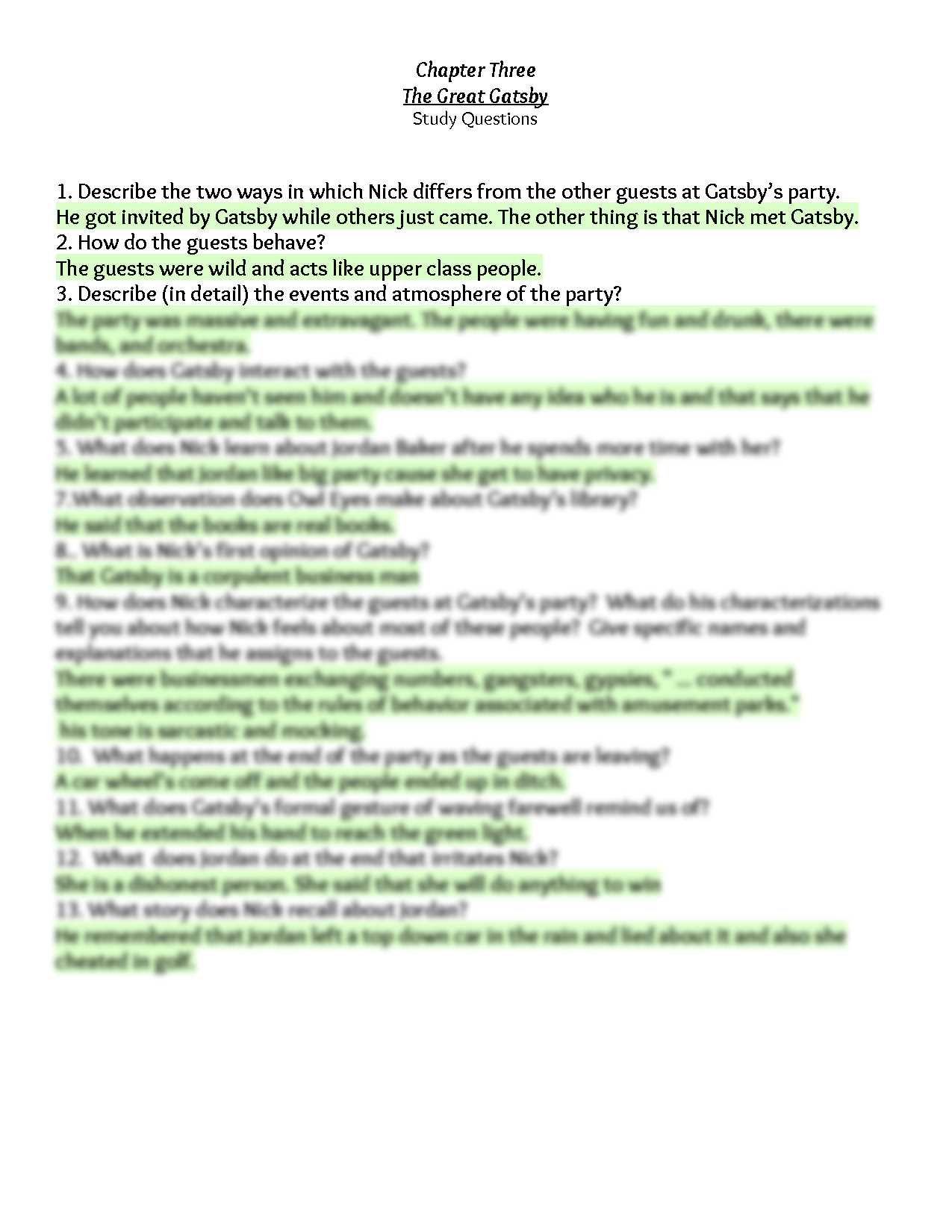
In the opening chapter, the mysterious figure of the man across the bay is introduced, leaving an air of intrigue and anticipation. His brief appearance marks a turning point in the narrative, creating a sense of curiosity and establishing him as a central, enigmatic figure. Though he is not fully revealed, this moment foreshadows his significant role in the unfolding story.
Nick Carraway’s first encounter with the man across the water is subtle yet impactful. The brief interaction–where Gatsby is seen standing on the lawn, staring out at the green light–sets the stage for the mystery surrounding his character. This image of a man who is both present and distant, longing for something just out of reach, serves as an early metaphor for his desires and the central themes of the novel.
The significance of this first glimpse lies not only in the mystery it creates but also in the symbolism of what the figure represents. His quiet presence, contrasted with the lavish parties and the excesses of the world around him, hints at a deeper longing and ambition that will shape the rest of the plot. It is this enigmatic nature that keeps the reader coming back, eager to learn more about this elusive character.
Nick’s Narration Style and Perspective
Nick Carraway’s role as the narrator is integral to how the story unfolds, as his perspective shapes the reader’s understanding of the events and characters. His narration is characterized by a mix of objectivity and personal insight, which provides both clarity and ambiguity. Through his eyes, the reader gets a filtered version of the world around him, where emotions and biases subtly color his observations.
Objective Yet Subjective
Nick’s narration appears neutral on the surface, often presenting events in a straightforward manner. However, his personal feelings toward the people and situations he describes seep through, revealing a more subjective interpretation. This duality invites readers to question the reliability of his account and consider how his background and experiences influence his storytelling.
Introspection and Reflection
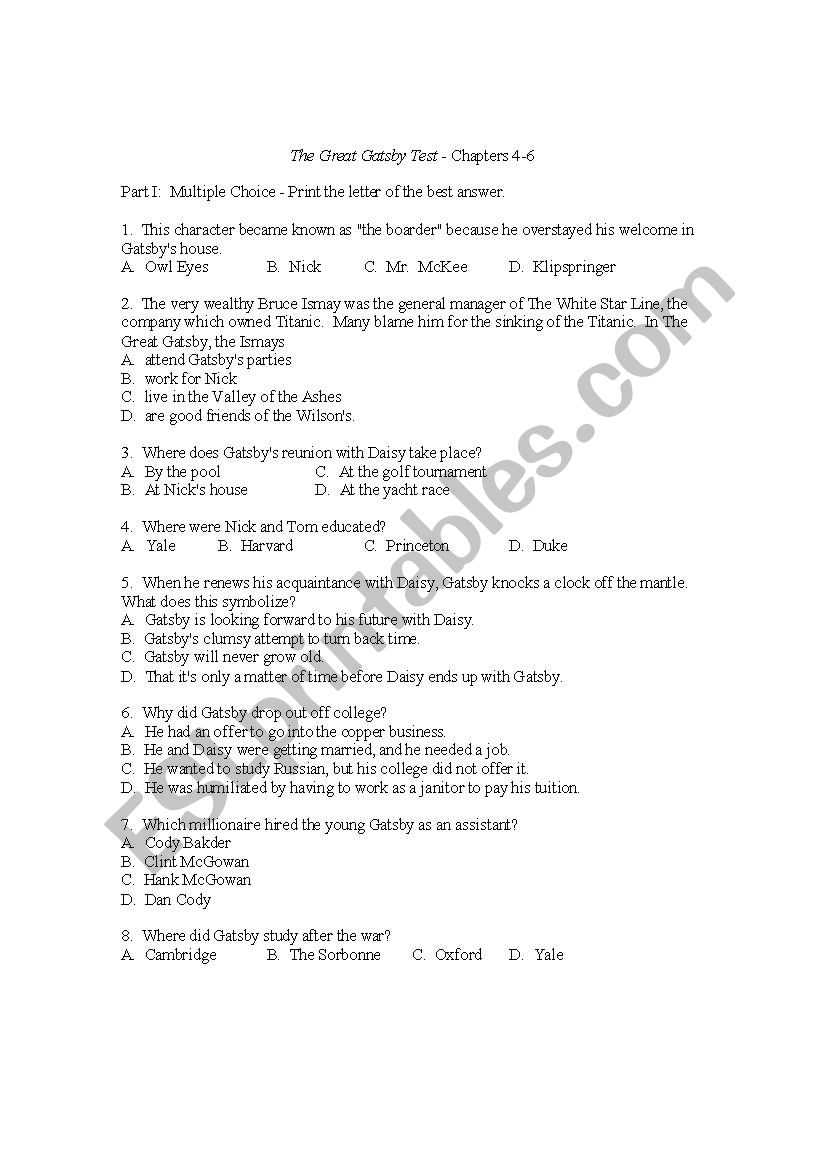
As an introspective narrator, Nick often reflects on his own experiences and decisions, offering a deeper layer of analysis to the events he recounts. His ability to step back and evaluate situations from a broader perspective allows the reader to see beyond the immediate action, highlighting the complex emotions and motivations driving the characters. This reflective nature adds depth to the narrative, encouraging a more nuanced understanding of the unfolding drama.
Exploring the Themes of Wealth and Class
Wealth and social standing are central themes that influence the actions, relationships, and choices of the characters in the story. These concepts are not only a measure of material success but also shape the characters’ identities, aspirations, and even their sense of morality. The novel delves deeply into the effects of both inherited and self-made wealth, drawing sharp distinctions between different social classes.
The Divide Between Old and New Money
One of the most significant contrasts explored is the division between old money, represented by characters from East Egg, and new money, embodied by those in West Egg. This divide reveals the tensions between tradition and modernity, where wealth alone is not enough to grant access to the exclusive circles of the established elite. The characters in these two groups often display differing values, behaviors, and attitudes toward success and power, reflecting the class struggles of the era.
Materialism vs. Authenticity
Another layer to the exploration of wealth is the tension between materialism and personal integrity. Characters like Tom Buchanan, who are born into wealth, use their social position to control and dominate others, while those seeking upward mobility–such as Jay Gatsby–are often portrayed as more idealistic, believing that wealth can buy love, acceptance, and fulfillment. This clash highlights the emptiness that can accompany material success, as the pursuit of wealth often comes at the expense of genuine human connection.
Symbolism in the Opening Chapter
The opening chapter is rich with symbolic imagery that sets the tone for the themes and conflicts that will unfold throughout the narrative. These symbols not only enhance the reader’s understanding of the story but also invite deeper reflection on the social, moral, and emotional landscapes in which the characters exist. Through subtle yet powerful imagery, the chapter introduces key motifs that resonate throughout the plot.
The Green Light
One of the most prominent symbols in the opening chapter is the green light across the bay, which holds significant meaning throughout the novel. Initially, it represents hope and ambition, particularly for one character who is striving to achieve something elusive. This symbol also touches on themes of longing, desire, and the pursuit of an ideal that may ultimately remain out of reach.
| Symbol | Meaning | Character Connection |
|---|---|---|
| Green Light | Hope, ambition, unattainable dreams | Jay Gatsby’s desire for Daisy |
| Nick’s Perspective | Introduction to the narrator’s view of others | Nick’s impartial yet reflective viewpoint |
The Eyes of Dr. T.J. Eckleburg
Another symbol introduced early in the story is the image of the eyes of Dr. T.J. Eckleburg, painted on a billboard in the Valley of Ashes. These eyes symbolize the moral and spiritual decay of society, representing a watchful presence over the characters’ actions. They also serve as a reminder of the disconnect between the material world and any higher, more meaningful existence.
The Party at Tom’s Apartment
In the first chapter, a key social event takes place at Tom Buchanan’s apartment, providing insight into the characters’ behaviors and the social dynamics at play. This gathering, attended by a mix of individuals, serves as a microcosm of the larger world in which these characters live–one dominated by excess, superficiality, and a lack of genuine connection. It’s a moment that exposes the complexities of Tom’s character and the moral decay present in the upper classes.
Tom’s Influence and Control
Tom’s apartment is not just a physical space; it represents his power and dominance over those around him. His ability to host an extravagant party shows his wealth and authority, but it also highlights his lack of genuine emotional connections. The way he treats his guests, especially his wife Daisy, and his lover Myrtle, reveals a character who is manipulative and entitled.
Guests and Atmosphere
The guests at the party are a mixture of personalities, yet they share a common trait: they are all complicit in the shallow, materialistic world that Tom inhabits. The atmosphere of the party is one of chaos and excess, where indulgence replaces meaningful conversation, and the focus is on appearance rather than substance.
- Luxurious setting with expensive furniture
- Heavy drinking and a lack of inhibition
- Superficial conversations and gossip
- Power dynamics between Tom, Daisy, and Myrtle
While the party itself might seem like a mere social gathering, it serves as a backdrop for revealing the darker aspects of the characters’ relationships. It highlights the tension between them, the lack of authenticity, and the way wealth and status shape their interactions.
Nick’s Observations of Social Divides
As the story unfolds, Nick Carraway offers insightful commentary on the clear divisions that exist between different social classes. Through his eyes, readers are introduced to the stark contrasts between wealth, background, and behavior that define the characters’ interactions. These divides go beyond material wealth, reflecting deeper issues of class, power, and social expectations. Nick’s observations serve as a critique of the time, highlighting the complex and often troubling realities of the world around him.
| Social Group | Characteristics | Nick’s Perspective |
|---|---|---|
| Old Money (East Egg) | Inherited wealth, privilege, tradition | Nick observes a sense of superiority, arrogance, and old-world values. |
| New Money (West Egg) | Self-made wealth, ambition, modernity | Nick sees them as striving for acceptance but often lacking social refinement. |
| Lower Classes (Myrtle, Others) | Working-class background, limited opportunities | Nick notes the desperation and desire for upward mobility, often leading to moral compromises. |
Through these different groups, Nick sees a society divided not only by wealth but by a rigid social structure that keeps individuals in their place. His observations highlight how deeply ingrained social divides influence behavior, relationships, and even personal identity. These divisions shape the narrative and provide a lens through which the reader can understand the underlying tensions between the characters.
The Role of Women in Chapter 1
In the opening chapter, women are depicted in a way that reflects the gender dynamics of the time. Through their interactions and behavior, the roles of women in the story are revealed to be complex yet constrained by societal expectations. While some of the female characters exhibit signs of power and independence, others are confined by traditional roles and the dominance of the men around them. These contrasting portrayals offer insights into the limitations and challenges women face in a male-dominated world.
The women in this chapter, such as Daisy and Myrtle, represent different aspects of femininity, from elegance and charm to desire for social ascent. Their roles are shaped by the men they interact with, and their identities often appear to be defined by their relationships to these men. Daisy, for example, is portrayed as delicate and somewhat passive, while Myrtle’s character is more assertive, yet still subjugated to Tom’s control. Both women, however, reflect the expectations placed on women in their society, particularly when it comes to marriage, social status, and power dynamics.
Nick’s observations also shed light on how women in this world are expected to maintain appearances, conform to social norms, and often suffer in silence. The limited agency of these characters in the first chapter sets the stage for understanding how they navigate the world of wealth, status, and social expectation in the narrative.
Foreshadowing in Chapter 1 Events
In the initial moments of the story, several key events and details hint at the future developments and conflicts that will unfold. These subtle clues create a sense of anticipation, suggesting that things may not be as perfect as they initially appear. Foreshadowing in the first chapter sets the stage for the drama, tension, and eventual tragedy that will define the narrative. Through carefully crafted moments, the author plants seeds of doubt, laying the groundwork for later revelations and outcomes.
| Event/Detail | Foreshadowed Outcome |
|---|---|
| Nick’s introduction to Tom’s aggressive nature | Hints at Tom’s domineering behavior and lack of moral restraint. |
| Daisy’s emotional instability | Foretells future conflicts in her relationships and her inner turmoil. |
| Nick’s description of Gatsby’s mansion from a distance | Suggests that Gatsby’s grand exterior may hide a more complicated and troubled reality. |
| Tom’s affair with Myrtle | Indicates future tensions and breakdowns in relationships. |
These initial moments in the first chapter create a sense of unease, hinting that the seemingly glamorous world of wealth and privilege is underpinned by conflict, dishonesty, and emotional complexity. Through foreshadowing, readers are subtly warned of the challenges and heartbreak that await the characters, reinforcing the themes of illusion versus reality that will become central to the narrative.
The Mood and Tone of the Chapter
The opening scenes set the emotional atmosphere for the entire narrative, establishing a complex mix of optimism, tension, and underlying unease. The initial sense of wonder and fascination quickly shifts to a more ambiguous tone as deeper layers of character dynamics and societal expectations are revealed. Through descriptive language and character interactions, the mood in the chapter shifts from intrigue to discomfort, creating an intricate balance that draws readers into the world of the story.
Descriptive Imagery and Setting
The mood is heavily influenced by vivid descriptions of locations and people, which play a significant role in shaping the overall atmosphere. The grand estates and luxurious settings contrast sharply with the more raw, emotional undercurrents felt by the characters. The author’s use of light, color, and imagery creates a setting that is both inviting and foreboding, contributing to the uneasy mood that permeates the chapter.
Character Interactions

Interactions between characters further enhance the tone, often revealing a sense of tension beneath the surface. For instance, Tom’s dominating behavior and Daisy’s ambiguous emotions inject the narrative with a tone of conflict and ambiguity. While some characters appear charming and appealing at first, subtle cues suggest that not everything is as it seems, fostering a feeling of apprehension for what lies ahead.
Overall, the chapter sets a tone of complexity, where external appearances mask deeper truths. The mood oscillates between hope and cynicism, reflecting the disillusionment and challenges that will unfold throughout the story.
Key Quotes from Chapter 1 Explained

Throughout the opening chapter, several powerful lines serve to highlight themes of wealth, disillusionment, and societal dynamics. These quotes provide a glimpse into the central conflicts and character motivations, offering important insights into the narrative’s tone and direction. Each of these selected statements offers layers of meaning that set the stage for the unfolding drama.
- “In my younger and more vulnerable years…” – This iconic opening line sets the reflective tone for the entire narrative. It suggests a time of innocence and self-awareness, hinting at Nick’s personal growth and the lessons he will learn throughout the story. The vulnerability mentioned here foreshadows the disillusionment that will unfold.
- “I hope she’ll be a fool–that’s the best thing a girl can be in this world, a beautiful little fool.” – Daisy’s cynical remark about her daughter reflects the limited roles and expectations placed on women in this society. Her statement underscores the theme of female disempowerment and the shallow, often superficial nature of social values.
- “Tom’s got some woman in New York.” – This line, casually dropped by Nick, reveals Tom’s infidelity and sets up the complex, morally ambiguous nature of his character. It hints at the darker side of wealth and privilege, where such actions are dismissed or tolerated without much consequence.
- “Gatsby, who represented everything for which I have an unaffected scorn.” – This line, reflecting Nick’s initial feelings toward Gatsby, introduces a key element of the narrative: the tension between admiration and disdain. Nick’s scorn for the figure of Gatsby hints at the personal struggles and conflicting emotions that will develop as the story progresses.
These quotes not only illuminate the characters’ personalities and motivations but also foreshadow the conflicts that will drive the plot. They are pivotal moments that help shape the reader’s understanding of the social structure and moral dilemmas central to the narrative.
How Chapter 1 Sets Up the Novel
The opening chapter plays a crucial role in introducing key themes, characters, and the social environment that will shape the entire narrative. In this initial segment, the groundwork is laid for the exploration of ambition, class struggles, and personal desires. Through carefully crafted interactions and subtle details, this chapter foreshadows the conflicts and dramatic developments that will unfold in the story.
Introducing Central Characters
In the first chapter, readers are introduced to some of the primary characters who will drive the plot forward. Through Nick Carraway’s observations and interactions, we begin to understand the dynamics between him and the others around him. The behaviors and attitudes of these figures set the stage for the moral complexities and personal conflicts that will come to light later in the narrative.
- Nick Carraway: As the narrator, Nick’s perceptions shape the reader’s understanding of the world around him. His first-person perspective brings a subjective view of the characters, especially of Tom Buchanan, Daisy, and others.
- Tom Buchanan: Tom’s arrogance and privilege are evident early on, establishing him as a symbol of wealth and power that is both entitled and morally questionable.
- Daisy Buchanan: Daisy’s charm and fragility are clear in her interactions, but also hints of disillusionment that will become more apparent as the story progresses.
Setting the Social Context
Beyond character introductions, the first chapter also establishes the setting, with its division between East Egg and West Egg. This geographical distinction symbolizes the broader divide between old money and new wealth, setting the stage for the social tensions and conflicts that will arise throughout the novel.
- East Egg: Representing old money, East Egg is home to those who have inherited their wealth and live with a sense of entitlement.
- West Egg: In contrast, West Egg houses the newly rich, individuals who have accumulated their fortunes through their own efforts, often leading to a sense of inauthenticity and pretension.
Overall, the first chapter subtly introduces the key elements that will dominate the rest of the novel. The characters, social divisions, and attitudes explored here act as a microcosm of the larger themes, drawing readers into a world where wealth, status, and desire intersect in complex and often destructive ways.